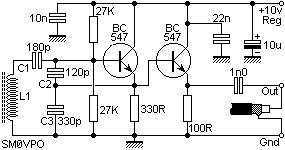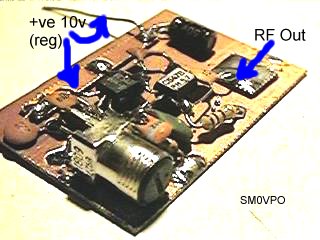

I have been asked many times how to make a basic RF oscillator. One of the most frequently asked questions is "my oscillator doesn't oscillate - Harry, what's wrong with it?" Of course, there is no way I can know the answer to that without actually being there, in person, armed to the teeth with my spectrum analyser and multimeter. Here then is a sample RF oscillator that works 1st-time, every time.

The circuit is ridiculously simple, so I will skip all the complicated maths and make component selection simple by using calculators. Let us assume I want an oscillator for 7MHz. The circuit looks like this:

The first transistor to the left (TR1) is a simple emitter-follower. It has a voltage gain of just under 1. The two 27K resistors can be as high as 100K, but if you want to use a lower gain transistor (2N2222 etc) then 27K is good. C2 and C3 work with L1 to form a voltage multiplier. The current is reduced, but TR1 is a current amplifier. In this way we have a total voltage/current gain of more than 1 between base and emitter. It will oscillate.
TR2 (the other one) is a simple emitter follower that is used only as a buffer between the oscillator and the outside world. Here then are the brief specifications of the oscillator:

I have included a few calculators here. Each time you see the text [Enter] you are being asked to enter data in the field. If you have previously used another calculator then there will already be default start values entered for you. These are the results of your previous calculaton. You may of course enter new values.

C1, C2 and C3 are all in series and so form a single tuning capacitor of about 60pf. The ratios of C2:C3 determine the gain and their values may vary quite a lot. In general, C2 = 3x wavelength, C3 = 9x wavelength. C1 can be any value from 1x wavelength to 10x wavelength and is normally chosen to fine-set the frequency of the oscillator. Make C1 start value about the same as C2. The actual values can vary over quite a wide range. This calculator will calculate the total tuning capacitance for your own selected values.
In the above calculator, enter a frequency and click the "SHOW C1, C2 & C3" button and the values of C1, C2 & C3 will be displayed. If you then click the "SHOW CAPACITANCE" button, you will see the value of the effective tuning capacitor that will be resonated with L1. You may also enter your own C1, C2 and C3 values to find the effective tuning capacitor that will be resonated with L1.

The inductor L1 resonates with the total capacitance above to determine the operating frequency. If you know the capacitance, having just read the the previous chapter, then use your basic frequency (transposed) to give inductance, or plonk your values in this little calculator:

Now you know the inductance and the capacitance, it is just to buy and insert those values into the circuit. But if you really want to wind the coils yourself, then you will probably use either air-cored 6mm Dia. formers, or use formers with a ferrite core. There are precise formulas to use but I like this method. Insert the required inductance and click the button.
Please remember that this last "calculation" is very approximate since a lot depends upon the individual former. The "Ferrite core" is assumed to be a re-wound IF can as shown in the photos below.

There are many types of construction one could use, but not all are any good. Veroboard, Breadboard and such commercial boards are almost useless for radio frequency work. Forget them!
Printed Circuit Boards (PCBs) are great for RF, but there should be loads of supply decoupling connecting the +ve and -ve copper tracks together. RF wiring is NOT like connecting a battery to a bulb (lamp). The "RF Earth" (ground) is usually the battery terminals and these copper planes should be as large as possible and cover as much area of the board as you can get. All other ptracks should be as short and thin as possible.
If you don't want to go to the trouble of making a full PCB, but want to make a good RF circuit one-off or just prototype for a PCB, then "Birdsnest", "Ratsnest" or "Ugglybug" is the way to go. This is what it could look like.


Very best regards, and have fun, from Harry - SM0VPO